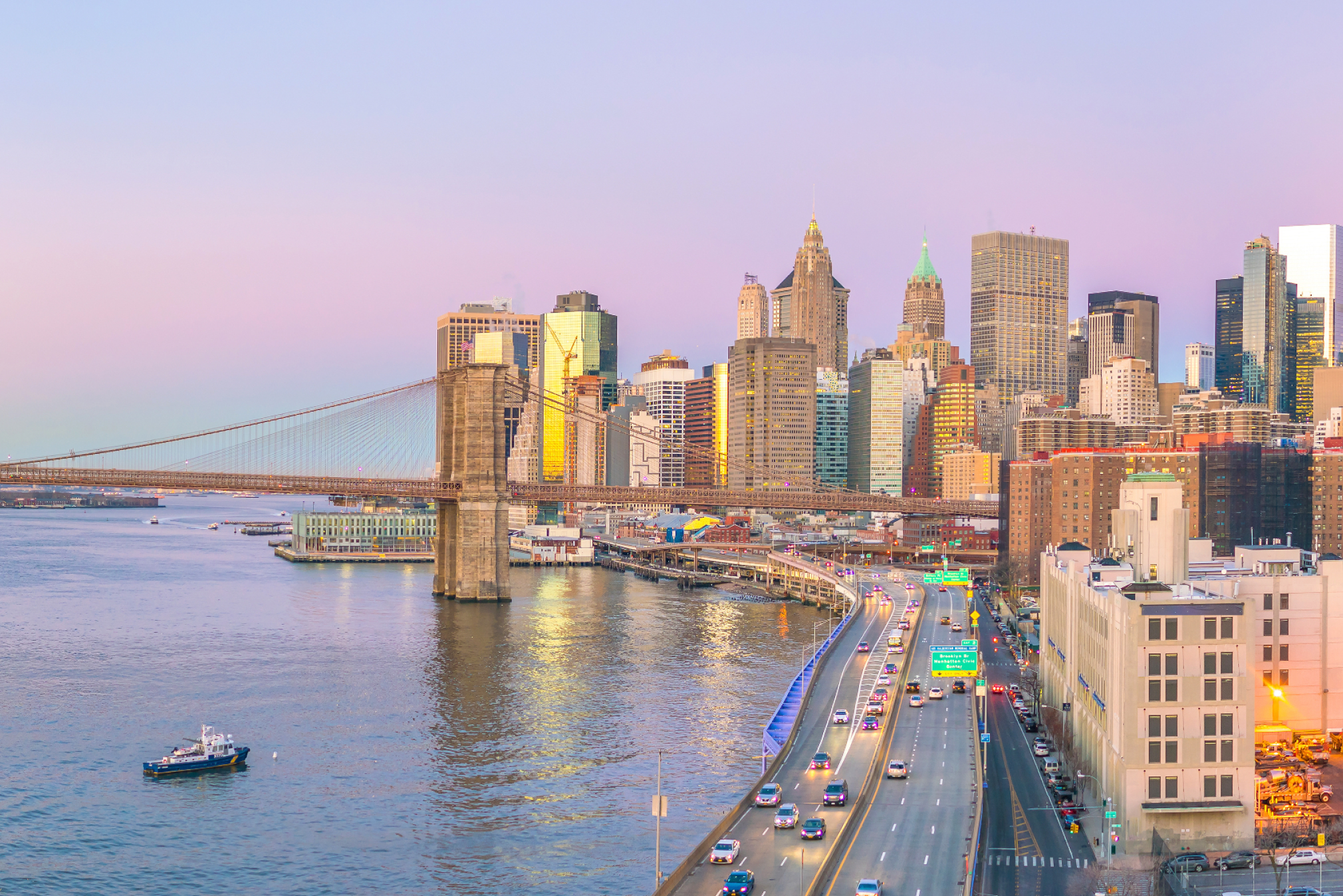Reflections from the 2024 Urban Tech Summit hosted by Cornell Tech
Home to 8.8 million residents, New York City is a living laboratory of urban resilience. As one of the world’s most complex urban ecosystems, the city is working to reimagine how metropolitan centers can become stronger, fairer, and more resilient in the face of climate change; climate innovations here can offer crucial lessons for cities worldwide.
Organized by the Urban Tech Hub at Cornell Tech’s Jacobs Institute, the 2024 Urban Tech Summit focused on the theme of “Intelligence for Climate Adaptation.” Organizers designed a program to explore how artificial intelligence technologies can be deployed to build more resilient urban environments. Over two days in November, leaders from across academia, government, industry, and civil society convened to share and learn about pressing opportunities and challenges facing cities. The Summit hosted talks, panels, and pitches covering topics including innovations in energy, transportation, and built infrastructure; climate threats such as flooding and extreme heat; and climate-focused applications of promising technologies like generative AI and digital twins. We’re reflecting on three key themes related to climate and innovation that we’re taking away from the event.
AI can help accelerate climate solutions
The pace of climate change is accelerating, with recent temperature readings causing alarm and threatening our ability to accurately forecast what comes next. Against this backdrop, artificial intelligence offers the potential to supercharge climate research and accelerate solutions that might meet the urgency of the crisis. Already, AI is helping climate scientists process and analyze massive datasets to improve climate models, predict extreme weather events with greater accuracy, and simulate future climate scenarios. We need to use every tool at our disposal to help cities mitigate, adapt, and evolve in the face of a changing climate.
At the Summit, participants discussed the need to balance a desire for precision with the need for immediate action, recognizing when data is “good enough” to move forward. In his opening remarks, Rohit Aggarwala, Commissioner, New York City Department of Environmental Protection and Chief Climate Officer, pushed the audience to interrogate what it will actually take for AI to make a difference in responses to climate change. He reflected that we don’t need to expend more effort understanding the urgency of climate change — the real information gap isn’t in understanding the problem. Instead, technologists and city leaders should focus on how technology can help design and implement solutions — and address the disproportionate impacts of climate change for historically underserved and underrepresented communities. The innovative applications and ideas on display across the Summit program conveyed the incredible opportunity to deploy AI to make a real impact in communities today.
While the opportunity is immense, AI solutions require thoughtful deployment on several fronts. AI — and large language models in particular — have a meaningful carbon and water footprint. Tech companies like Google and Microsoft are facing setbacks in achieving their climate goals and attribute these setbacks to the electricity required to power AI tools. Yet speakers at the conference added nuance to this debate: Not all AI is created with an equal footprint. Many AI-powered climate solutions use small data sets, consuming a relatively small amount of electricity and water. In addition, the energy consumption from AI is relatively minor when compared to the electrification transition that other industries will need to undergo.
The discussions at the Summit embodied the spirit of the AI for Climate and Nature Grand Challenge, a $100 million initiative that Luminary Labs designed in partnership with the Bezos Earth Fund earlier this year. That program explores new ideas for multiplying the impact of climate and nature efforts using modern AI and seeks to help the most impactful climate interventions make strategic use of transformative technologies. AI will have a role to play in the effort to address climate change, but its success will hinge on thoughtful deployment, collaboration, and honest engagement with the opportunities — and challenges — it presents.
Innovation must focus on human impact
A key theme of the conference was how to ensure solutions and tools meet human needs and benefit communities. We know that climate impacts are not felt equally — even in the same city or neighborhood, one street can be far more vulnerable to climate disasters than another just a few blocks away. Furthermore, climate impacts don’t just manifest in dramatic weather events, but also in chronic, persistent challenges that disproportionately affect those with the fewest resources to adapt. New technology can help refine and hone our assessments, interventions, and tools better to protect people and communities from present and future climate impacts.
New York City offers a stark illustration of how climate change creates uneven burdens across communities. In and around Jamaica Bay, households face chronic tidal flooding that leads to persistent mold problems in basements — and they lack adequate warning systems or protection infrastructure. Flooding impacts from rainstorms can vary dramatically, even within neighborhoods. This reality was tragically revealed during Hurricane Ida when ten people drowned in unprecedented inland flooding — a devastating example of how physical location, social vulnerability, and climate change intersect with fatal consequences. We also know that the harmful impacts of rising heat and heat waves won’t be felt equally; compared to suburban or rural areas, cities will experience higher temperatures, and “intra-urban heat islands” will leave some communities more vulnerable.
Across the two-day event, we encountered inspiring examples of how AI can help planners, policy makers, and communities better allocate resources and plan for potentially life-saving interventions. Projects like FloodNet NYC make data more accessible, but there is opportunity to make this data actionable. A wayfinding solution could communicate with residents living in flood-prone areas to help them protect themselves, their neighbors, and their homes during storms.
Technology has the potential to level the playing field for communities that are historically underserved and underrepresented in areas that are often more subject to disasters, but that outcome is not guaranteed. AI-powered climate solutions will need to focus on human impact, prioritize trust and safety, and ensure relevance and access for those communities left most vulnerable.
Bold solutions, at every level
Many conversations at the Summit returned to the theme of systemic transformation; while new apps and startups have a role, they will not solve the climate crisis alone. The Summit emphasized the urgency of adapting the city’s transportation, energy, and built infrastructure to be more resilient and more efficient. Jen Hensley, Senior Vice President of Corporate Affairs at Con Edison, explained how the utility is investing significant resources to adapt its systems and transition to cleaner energy sources. In New York, longer, hotter summers and more intense storms will stress energy infrastructure and make regular maintenance more difficult. Beyond the material challenges, the transition to greener energy will demand a larger and more skilled energy workforce. The challenges of a changing climate will require that we invest more, work smarter, and collaborate better to transform cities.
According to the Climate Policy Initiative, annual climate finance represents only about 1% of global GDP and must increase by at least five-fold by 2030 to avoid the worst impacts of climate change. And with much of current climate financing still coming from public sources, greater private investment is critical. In his keynote address at the Summit, Adam Freed, Principal, Bloomberg Associates, offered this assessment: “we need the will to act, data to target, and revenue to scale.”
With such need for action, cities need to leverage new approaches to defining problems and finding solutions in new ways. Open innovation can serve as a powerful tool for the public and private sectors by bringing diverse partners together to focus on targeted solutions. Cities can use open innovation programs, such as incentive prizes and accelerators, to focus attention on urgent priorities and stimulate private investment. One particularly promising development is the evolution of government procurement, as more cities are adopting challenge-based or problem-based procurement approaches. New York City recently adopted a rule to emphasize city agencies’ ability to use the challenge-based solicitation model. This shift represents how essential public functions can be reimagined to meet contemporary challenges, ensuring resources and attention remain focused on the most pressing needs.
Identifying and scaling impactful solutions will require collaboration across government and beyond. In America’s cities, planners, and policy leaders will need to cultivate new partnerships, work to break down institutional silos, and streamline arcane processes. With a focus on the right problems and commitment to human impact, tech innovation — including AI — can make cities and communities stronger and more resilient.



